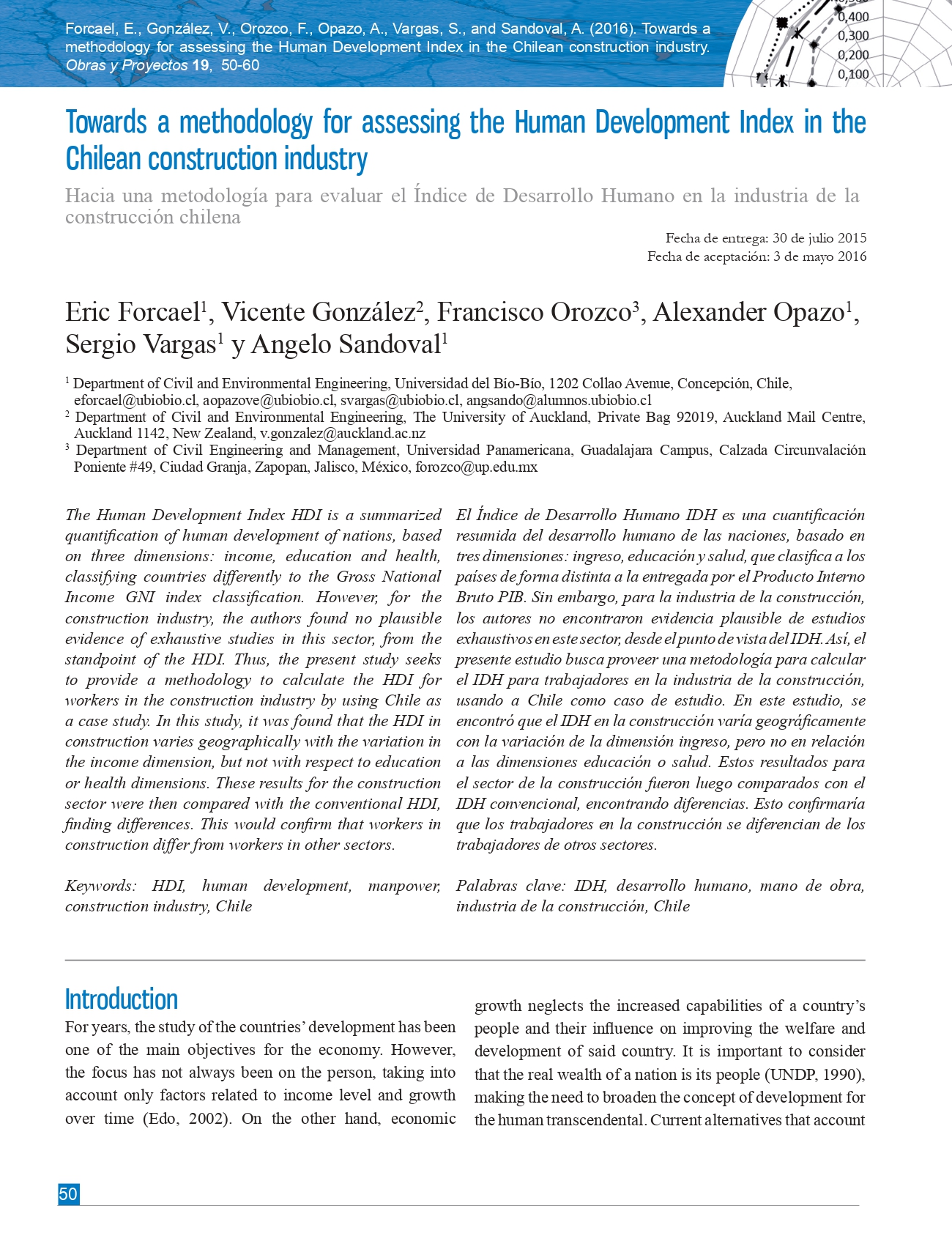Towards a methodology for assessing the Human Development Index in the Chilean construction industry
DOI:
https://doi.org/10.4067/S0718-28132016000100004Keywords:
HDI, human development, manpower, construction industry, ChileAbstract
The Human Development Index HDI is a summarized quantification of human development of nations, based on three dimensions: income, education and health, classifying countries differently to the Gross National Income GNI index classification. However, for the construction industry, the authors found no plausible evidence of exhaustive studies in this sector, from the standpoint of the HDI. Thus, the present study seeks to provide a methodology to calculate the HDI for workers in the construction industry by using Chile as a case study. In this study, it was found that the HDI in construction varies geographically with the variation in the income dimension, but not with respect to education or health dimensions. These results for the construction sector were then compared with the conventional HDI, finding differences. This would confirm that workers in construction differ from workers in other sectors.
References
Booysen, F. (2002). An overview and evaluation of composite indices of development. Social Indicators Research 59(2), 115-151. https://doi.org/10.1023/A:1016275505152
CChC (2011). Informe Mach, Macroeconomía y Construcción N° 33. Cámara Chilena de la Construcción, http://www.cchc.cl
CPWR (2009). Hispanic employment in construction. Center to Protect Workers’ Rights Data Brief 1(1), 1-17
de Souza, U. (2000). Managing workers in production: overview of labour in the building industry. Translation of a presentation, University of Sao Paulo, Brazil.
Edo, M. (2002). Amartya Sen y el desarrollo como libertad (Amartya Sen and the development as freedom). B. thesis, Torcuato Di Tella University, Argentina
Griffin, K. (2001). Desarrollo Humano: origen, evolución e impacto. En Ensayos sobre el desarrollo Humano, Ibarra, P. y Unceta, K. (coord.), 25-40, Ed. Icaria, Barcelona
Hanna, A.S. (2001). Quantifying the impact of change orders on electrical and mechanical labor productivity. Research Rep. No. 158-11, Construction Industry Institute, Austin
Haq, M. (2003). The Birth of the Human Development Index. In Readings in Human Development, Sakiko Fukuda-Parr and A.K. Shiva Kumar (eds.), Oxford University Press, New York, 127-137
Haq, M. (1995). Reflections on human development. Oxford University Press, New York
Harmon, K.M. and Cole, B. (2006). Loss of productivity studies-current uses and misuses. Construction Briefs 8(1), 1-19
Hinze, J. and Russell, D. (1995). Analysis of fatalities recorded by OSHA. Journal of Construction Engineering and Management 121(2), 209-214
Hinze, J. and Teizer, J. (2011). Visibility-related fatalities related to construction equipment. Safety Science 49(5), 709-718. https://doi.org/10.1016/j.ssci.2011.01.007
ILO (2001). The construction industry in the twenty-first century: its image, employment prospects and skill requirements. Tripartite Meeting, Geneva, Switzerland
Kelley, A. (1991). The human development Index: Handle with Care. Population and Development Review 17(2), 315-324. https://doi.org/10.2307/1973733
Kruskal, W.H. and Wallis, W.A. (1952). Use of ranks on one-criterion variance analysis. Journal of the American Statistical Association 47(1), 583-621. https://doi.org/10.2307/2280779
Levin, R. and Rubin, D. (1998). Statistics for Management. 7th ed., Prentice-Hall
Liu, M. and Ballard, G. (2008). Improving labor productivity through production control. Proceedings of the 11th Annual Conference of International Group for Lean Construction, Manchester, UK
MINSAL (2012). Estimación de AVPP y Esperanza de Vida: Tutoriales Diagnósticos Regionales, Módulo 6. Ministerio de Salud de Chile.
NENE (2012). Estadísticas de empleo, trimestre junio-julio-agosto 2012. Ocupados por actividad, nivel nacional y regional. www.ine.cl
Pol, M.A. (2007). Desarrollo Humano y Territorio: Una aproximación metodológica. Tesis de doctorado, Universidad de Alicante, España
Pollack, E.S, Griffin, M., Ringen, K. and Weeks J.L. (1996). Fatalities in the construction industry in the United States, 1992 and 1993. American Journal of Industrial Medicine 30(3), 325-330. https://doi.org/10.1002/(sici)1097-0274(199609)30:3%3C325::aid-ajim11%3E3.0.co;2-y
Ramos, C. and Acosta, E. (2006). El impacto de los informes de desarrollo humano del PNUD en Chile. Universidad Alberto Hurtado, Chile.
Ranis, G. and Stewart, F. (2001). Growth and human development: comparative Latin American experience. Developing Economics 39(4), 333-365
Rivas, R., Borcherding, J.D., González, V and Alarcón, L.F. (2011). Analysis of factors influencing productivity using craftsmen questionnaires: a case study in a Chilean construction company. Journal of Construction Engineering and Management 137, N°4, 312-320. https://doi.org/10.1061/(ASCE)CO.1943-7862.0000274
Sen, A. (1997). Human capital and human capability. World Development 25(12), 1959-1961
Sen, A. (1983). Development: Which Way Now?. The Economic Journal 93(372), 745-762
Torres, T. and Allepuz, R. (2009). El desarrollo humano: perfiles y perspectivas futuras. Estudios de Economía Aplicada 27(2), 545-562
UGT (General Union of Workers). (1999). Guía para la prevención de riesgos laborales: Sector de la construcción. Unión General de Trabajadores, España
UNDP (1990, 1991, 1992, 1997, 1999a). Human development report 1990 (1991, 1992, 1997, 1999). Oxford University Press, Inc. Oxford, New York
UNDP (1999b). Índice de Desarrollo Humano en Chile 1990-1998: Temas de Desarrollo Humano Sustentable N°3, Santiago, Chile
UNDP (2006, 2010, 2011). Human Development Report 2006 (2010, 2011). Palgrave Macmillan. New York
UNDP (2013). Human Development Report 2013. Communications Development Incorporated, Washington
UNDP-MIDEPLAN (2000). Desarrollo humano en las comunas de Chile. Temas de Desarrollo Humano Sustentable N°5. Santiago, Chile
UNDP-MIDEPLAN-Universidad de la Frontera (2003). El Índice de Desarrollo Humano en la Población Mapuche de la Región de La Araucanía. Temas de Desarrollo Humano Sustentable N°8, Santiago, Chile
UNDP-MIDEPLAN (2006). La trayectoria del desarrollo humano en las comunas de Chile, 1994-2003: Temas de Desarrollo Humano Sustentable N°11, Santiago, Chile

Downloads
Published
Issue
Section
License
Copyright (c) 2016 Universidad Católica de la Santísima Concepción

This work is licensed under a Creative Commons Attribution-NonCommercial 4.0 International License.







